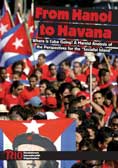




 Cuba was historically dominated by imperialism, first as a colony of Spain and then as a semi-colony of the United States. The island gained independence in 1902, but the Cuban constitution included an amendment granting the United States the right to intervene militarily at any time until 1934. The political power of US imperialism had an economic foundation, since US companies owned a large part of Cuba’s land and industry. For example, US capital owned 35% of sugar production, alongside countless hotels and casinos, while the rest of the economy belonged to a small and slavishly pro-imperialist Cuban bourgeoisie[4].
Cuba was historically dominated by imperialism, first as a colony of Spain and then as a semi-colony of the United States. The island gained independence in 1902, but the Cuban constitution included an amendment granting the United States the right to intervene militarily at any time until 1934. The political power of US imperialism had an economic foundation, since US companies owned a large part of Cuba’s land and industry. For example, US capital owned 35% of sugar production, alongside countless hotels and casinos, while the rest of the economy belonged to a small and slavishly pro-imperialist Cuban bourgeoisie[4].
This left the Cuban population, especially in the countryside, in poverty and ignorance. In 1952, when it appeared that the Orthodox Party had won the presidential election with a program demanding social reforms and more economic independence, the Cuban military under Fulgencio Batista established a dictatorship with the support of the USA. Cuba only gained real independence with the revolution of 1959.
The Cuban Revolution was led by a guerilla movement under the leadership of Fidel Castro, a lawyer and former member of the Orthodox Party who had tried to go to court against the Batista dictatorship before beginning the armed struggle with the attack on the Moncada barracks on July 26, 1953. Castro’s 26th of July Movement (M-26-J) represented a coalition of classes: petty bourgeois peasants, rural semi-proletarians, bourgeois intellectuals and some workers. Its main social base was, as is the case with any guerrilla army, the poor and landless peasantry. As a result, the movement had no clear ideology or political program – the M-26-J never even held a conference to determine its policy! This chaotic organization gave the leadership a great deal of autonomy from its base: decisions were made via pronouncements by the leaders rather than democratic decision-making by the members.
The guerilla’s goal, as they explained in the “Manifesto of the Sierra Maestra” in 1957, was “the beautiful ideal of a free, democratic and just Cuba.”[5] They called on the USA to stop selling weapons to the Cuban dictatorship which was violating human rights. While some activists from Castro’s inner circle were sympathetic to Stalinism (such as his brother Raúl or Ernesto “Che” Guevara), the guerilla was not fighting for a social revolution. Its goals were progressive – including the fight against illiteracy and unemployment, the creation of a parliamentary democracy, the development of industry and especially a land reform – but they did not go beyond the framework of capitalism.
The collapse of the dictatorship was not exclusively due to the activities of the guerilla, whose several thousand fighters were massively outgunned and outnumbered by Batista’s army. It was a general strike by the Cuban workers that finally led Batista to flee the country on New Year’s Eve of 1958[6]. This created a power vacuum that was filled by the small but well-organized M-26-J when it entered Havana eight days after Batista’s flight.
Notes
4. Workers Power/Irish Workers’ Group: The Degenerate Revolution. London 1982. S. 82.
5. M-26-J: Manifesto of the Sierra Maestra.
6. For more about the role of the workers movement in the Cuban Revolution, see: Steve Cushion: “The Working Class in the Cuban Revolution.” Permanent Revolution #14. London 2009. S. 34-40.
Leave a Reply
